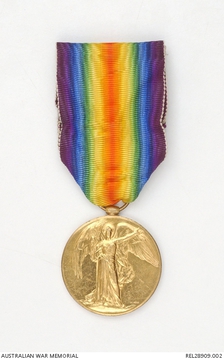
S10312
WARREN, William Frank
| Service Number: | 4981 |
|---|---|
| Enlisted: | Not yet discovered |
| Last Rank: | Private |
| Last Unit: | 32nd Infantry Battalion |
| Born: | Maylands, South Australia, December 1890 |
| Home Town: | Norwood (SA), South Australia |
| Schooling: | Not yet discovered |
| Occupation: | Salesman |
| Died: | 20 September 1938, cause of death not yet discovered, place of death not yet discovered |
| Cemetery: | Not yet discovered |
| Memorials: | Rose Park Public School WW1 Honour Board |
World War 1 Service
| 27 Jun 1916: | Involvement Private, 4981, 27th Infantry Battalion, --- :embarkation_roll: roll_number: '15' embarkation_place: Melbourne embarkation_ship: HMAT Barambah embarkation_ship_number: A37 public_note: '' | |
|---|---|---|
| 27 Jun 1916: | Embarked Private, 4981, 27th Infantry Battalion, HMAT Barambah, Melbourne | |
| 5 Mar 1917: | Wounded AIF WW1, Private, 4981, 32nd Infantry Battalion, Warren was wounded in action due to a shell concussion. | |
| 11 Nov 1918: | Involvement Private, 4981, 32nd Infantry Battalion | |
| 11 Nov 1918: | Involvement Private, 4981, 32nd Infantry Battalion |
Help us honour William Frank Warren's service by contributing information, stories, and images so that they can be preserved for future generations.
Add my storyBiography contributed by St Ignatius' College
William Frank Warren was a South Australian soldier that fought and contributed his time to the Australian Infantry during World War One. He was born in December 1890 in the suburb of Maylands, South Australia. Prior to his enlistment as a soldier in World War One William worked as a Salesman. As shown on his service record he didn’t have any previous military service, however he had applied and been rejected from the army on account of his chest measurement and nerves. The next of kin that he had chosen was his mother as he was not married. Amelia Warren (mother) lived at 69 George Street, Norwood which is an area that is known by most South Australians.
He enlisted on January 24th 1916 in Adelaide and took the service number of 4981. He embarked for the War on the HMAT Barambah A37 from Melbourne, Australia. According to his records William embarked to France as acting corporal but reverted to a private in October of 1917. He was then appointed two days later as acting corporal again, only to be reverted again to private in the same month of October 1917. The change in his rank shows that he was good at what he was doing and showed great leadership.
William was originally assigned to the 27th Infantry Battalion and was quickly transferred to the 32nd and later the 42nd Battalion. Given that he was taken on strength to many different units, he spent most of his time and fought with the 32nd Infantry Battalion. Majority of the soldiers in the unit came from urban areas but there was many also that came from more rural areas. The battalion itself was quite diverse including men of British origin, Nordics, Russians and Aboriginal Australians. The major battle fought for the unit was at Fromelles on 19th July 1916. William, however did not take part in this conflict as he was still training for battle at the time.
He found himself with a very mild case of the common disease of “Trench foot” on 21st November 1916 and was taken out of the front line back to training in field, five days later he returned back into action. A short period of time after this, he had also acquired a medical illness, being admitted to hospital 2nd December 1917 and released 5th December but not able to rejoin the unit until 30th April 1918.
It was quite common for soldiers to be sly and be absent without leave from the army but when they were caught they received what was at the time, harsh punishments. William took approved leave multiple times but was recorded guilty for taking leave without pay once from midnight 3rd June, to 1:50pm 4th June 1919. As a consequence for this he was forfeited two days’ pay.
William was wounded in action during World War One twice within the space of three days. The first was due to a shell concussion on 5th March 1917 and did not return to the battalion back in the field until 25th March 1917. This took place in Trones Wood whilst the battalion faught on the front line. The second on 8th March 1917 by having his chest crushed by explosions, both times wounded in the well known battle of Somme.
William was one of the fortunate soldiers to come home from the First World War, returning to Australia on 4th July 1919 disembarking in Adelaide on 16th August 1919. He was awarded with the Victory Medal and British War Medal and lived safely after the War before passing on 20th September 1938.











